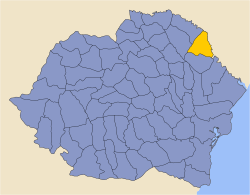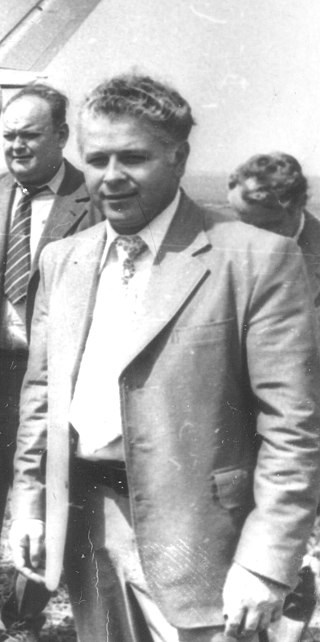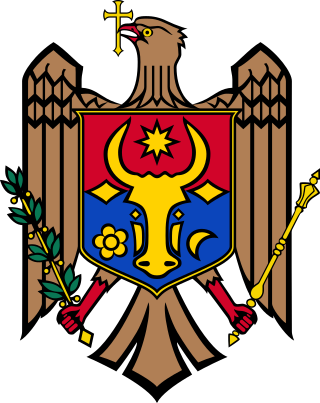Moldova , officially the Republic of Moldova, is a country in southeastern Europe.
Contents
Moldova or Moldavia may also refer to:
Moldova , officially the Republic of Moldova, is a country in southeastern Europe.
Moldova or Moldavia may also refer to:

The history of Moldova can be traced to the 1350s, when the Principality of Moldavia, the medieval precursor of modern Moldova and Romania, was founded. The principality was a vassal of the Ottoman Empire from 1538 until the 19th century. In 1812, following one of several Russian–Turkish wars, the eastern half of the principality, Bessarabia, was annexed by the Russian Empire. In 1918, Bessarabia briefly became independent as the Moldavian Democratic Republic and, following the decision of the Parliament, united with Romania. During the Second World War it was occupied by the Soviet Union which reclaimed it from Romania. It joined the Union as the Moldavian ASSR, until the dissolution of the USSR. In 1991 the country declared independence as the Republic of Moldova.

Bessarabia is a historical region in Eastern Europe, bounded by the Dniester river on the east and the Prut river on the west. About two thirds of Bessarabia lies within modern-day Moldova, with the Budjak region covering the southern coastal region and part of the Ukrainian Chernivtsi Oblast covering a small area in the north.

The Moldavian Soviet Socialist Republic or Moldavian SSR, also known as the Moldovan Soviet Socialist Republic, Moldovan SSR, or simply Moldavia or Moldova, was one of the 15 republics of the Soviet Union which existed from 1940 to 1991. The republic was formed on 2 August 1940 from parts of Bessarabia, a region annexed from Romania on 28 June of that year, and parts of the Moldavian Autonomous Soviet Socialist Republic, an autonomous Soviet republic within the Ukrainian SSR.

Bender or Bendery, also known as Tighina, is a city within the internationally recognized borders of Moldova under de facto control of the unrecognized Pridnestrovian Moldavian Republic (Transnistria) (PMR) since 1992. It is located on the western bank of the river Dniester in the Romanian historical region of Bessarabia.

The flag of the Moldavian Soviet Socialist Republic was adopted on 31 January 1952. The flag has three horizontal bands of red, green (1/4) and red, with a hammer and sickle in the canton. As defined by the Presidium of the Supreme Soviet of the Moldavian Soviet Socialist Republic on the flag description:
The national flag of the Moldavian Soviet Socialist Republic consists of a panel of red color with a green stripe in the middle of the whole flag length, with the image on top of the red part of the flag from the flagpole golden hammer and sickle above a five-pointed red star framed by gold border. The ratio of the flag's width to its length is 1:2 with the bandwidth of green to the width of the flag 1:4

Budjak, also known as Budzhak, is a historical region that was part of Bessarabia from 1812 to 1940. Situated along the Black Sea, between the Danube and Dniester rivers, this multi-ethnic region covers an area of 13,188 km2 (5,092 sq mi) and is home to approximately 600,000 people. The majority of the region is now located in Ukraine's Odesa Oblast, while the remaining part is found in the southern districts of Moldova. The region is bordered to the north by the rest of Moldova, to the west and south by Romania, and to the east by the Black Sea and the rest of Ukraine.

The Moldavian Autonomous Soviet Socialist Republic, shortened to Moldavian ASSR, was an autonomous republic of the Ukrainian SSR between 12 October 1924 and 2 August 1940, encompassing the modern territory of Transnistria as well as much of the present-day Podilsk Raion of Ukraine. It was an artificial political creation inspired by the Bolshevik nationalities policy in the context of the loss of larger Bessarabia to Romania in April 1918. In such a manner, the Bolshevik leadership tried to radicalize pro-Soviet feelings in Bessarabia with a goal to return it in the presence of favorable conditions and creation of geopolitical "place d'armes" (bridgehead) to execute a breakthrough in the Balkan direction by projecting influence upon Romanian Bessarabia, which was eventually occupied and annexed in 1940 after the signing of the Molotov–Ribbentrop Pact.

Moldovans, sometimes referred to as Moldavians, are a Romanian-speaking ethnic group and the largest ethnic group of the Republic of Moldova and a significant minority in Ukraine and Russia. There is an ongoing controversy, in part involving the linguisitic definition of ethnicity, over whether Moldovans' self-identification constitutes an ethnic group distinct and separate from Romanians, or a subset. The extent of self-identification as Romanians in the Republic of Moldova varies.

The Soviet deportations from Bessarabia and Northern Bukovina took place between late 1940 and 1951 and were part of Joseph Stalin's policy of political repression of the potential opposition to the Soviet power. The deported were typically moved to so-called "special settlements" (спецпоселения).

Moldovenism is a term used to describe the political support and promotion of a Moldovan identity and culture, including a Moldovan language, independent from those of any other ethnic group, the Romanians in particular. It is primarily used as a pejorative by the opponents of such ideas as part of the wider controversy over ethnic and linguistic identity in Moldova.

This is the history of Transnistria, officially the Pridnestrovian Moldavian Republic (PMR), an unrecognised breakaway state that is internationally recognised as part of Moldova. Transnistria controls most of the narrow strip of land between the Dniester river and the Moldovan–Ukrainian border, as well as some land on the other side of the river's bank.
The union of Bessarabia with Romania was proclaimed on April 9 [O.S. March 27] 1918 by Sfatul Țării, the legislative body of the Moldavian Democratic Republic. This state had the same borders of the region of Bessarabia, which was annexed by the Russian Empire following the Treaty of Bucharest of 1812 and organized first as an Oblast and later as a Governorate. Under Russian rule, many of the native Tatars were expelled from parts of Bessarabia and replaced with Moldavians, Wallachians, Bulgarians, Ukrainians, Greeks, Russians, Lipovans, Cossacks, Gagauzes and other peoples, although colonization was not limited to formerly Tatar-inhabited lands. Russia also tried to integrate the region by imposing the Russian language in administration and restricting education in other languages.

Orhei was a county in the Kingdom of Romania between 1925 and 1938, and again between 1941 and 1944, with the seat at Orhei.

Semion Grossu is a Moldovan politician and businessman.

Ivan Ivanovich Bodiul was a Soviet and Moldovan politician prominent in the Moldavian SSR, particularly during the Brezhnev era.

An election for a Supreme Soviet took place in Moldavia on January 12, 1941. The poll was an effort to legitimize the Soviet occupation of Bessarabia and Northern Bukovina which had taken place after Romania agreed to evacuate its administration in June 1940. Since 1918 these regions had been annexed by Romania, however the Soviet Union had maintained an active claim. All 266 deputies returned were elected on the common list of the Communist Party of Moldavia and non-partisans. The Supreme Soviet subsequently adopted the 1941 Constitution of the Moldavian Soviet Socialist Republic, under which the MSSR was a constituent of the Soviet Union. Soviet control was interrupted by the Axis occupation from June 1941 to 1944.
Igor Cașu is a historian from the Republic of Moldova.

Moldavia, also called Romanian Moldavia, is the core historic and geographical part of the former Principality of Moldavia situated in eastern and north-eastern Romania. Until its union with Wallachia in 1859, the Principality of Moldavia also included, at various times in its history, the regions of Bessarabia, all of Bukovina, and Hertsa; the larger part of the former is nowadays the independent state of Moldova, while the rest of it, the northern part of Bukovina, and Hertsa form territories of Ukraine.

Greater Moldova or Greater Moldavia is an irredentist concept today used for the credence that the Republic of Moldova should be expanded with lands that used to belong to the Principality of Moldavia or were once inside its political orbit. Historically, it also meant the unification of the lands of the former principality under either Romania or the Soviet Union. Territories cited in such proposals always include Western Moldavia and the whole of Bessarabia, as well as Bukovina and the Hertsa region; some versions also feature parts of Transylvania, while still others include areas of Podolia, or Pokuttia in its entirety. In its most post-Soviet iterations, "Greater Moldova" is associated with a belief that Moldovans are a distinct people from Romanians, and that they inhabit parts of Romania and Ukraine. It is a marginal position within the Moldovan identity disputes, corresponding to radical forms of an ideology polemically known as "Moldovenism".
The Day of the Union of Bessarabia with Romania is a public holiday of Romania celebrated every 27 March to commemorate the union of Bessarabia with Romania on 27 March 1918. Bessarabia is a Romanian historical region that was part of the Principality of Moldavia, which united with Wallachia to form modern Romania. The region was annexed in 1812 by the Russian Empire, but it became independent and united with Romania on 27 March 1918.